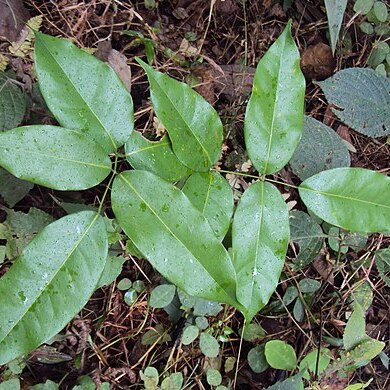Lianas or climbing shrubs, to 25 m tall. Branchlets dark brown, terete, glabrous or sparsely pubescent when young. Leaves odd-pinnate, rarely 1-foliolate; petiole, rachis, and petiolules glabrous; leaflets 1–3-paired, usually 1-paired; leaflet blade ovate or elliptic to lanceolate, 3–12 × 2–5 cm, (terminal one ovate or long elliptic and larger), papery, glabrous and smooth on both surfaces, lateral veins 5–10-paired, jointed near margin, midvein and reticulate veins prominent abaxially, base broadly cuneate to rounded, equilateral or slightly oblique, margin entire, apex acute to shortly acuminate. Inflorescences axillary or pseudoterminal, laxly paniculate or subracemose with 1–6 axes, 3–9 cm, many flowered, central one much longer than others; rachis and pedicels glabrous. Flowers ca. 1 cm in diam., fragrant. Sepals ovate, 2–3 × 1.5–2 mm, margin ciliate at apex. Petals white or yellow, long elliptic, 4–6 × 1–1.5 mm, glabrous, longitudinally striate. Stamens 2–6 mm. Carpels free, ca. 4 mm, glabrous. Follicle dark green, turning black when dry, obliquely ellipsoid, slightly curved, 1.5–2.5 × 0.7–1.5 cm, longitudinally striate, dehiscing along adaxial suture, with persistent calyx, apex acute. Seed red, ellipsoid, 1.5–2 × 0.6–1 cm, base covered by membranous aril. Fl. Apr–Oct, fr. May–Mar of following year.
More
Usually a large liana, rarely a shrub or treelet. Twigs glabrous or the young parts minutely tomentose. Leaves unifoliolate to 9-jugate, almost always glabrous; lateral petiolules (0.5-)2-6 mm long. Leaflets suborbicular or ovate to lanceolate, terminal ones sometimes obovate, 1-25 by ½-10 cm, thin-chartaceous to coriaceous, smooth and shining on both sides or minutely papillose and dull to slightly glaucous beneath; base equilateral to oblique, acute to cordate; apex short and broad to caudate acuminate, acumen blunt; nerves 4-7(-11) pairs, either neatly pinnate or more or less triplinerved, always distinctly looped and joined near the margin; reticulations inconspicuous to distinctly minutely tessellate. Inflorescences mainly in the upper leaf-axils, or pseudo-terminal, consisting of 1-5 axes, central one up to 20 cm long, the other ones distinctly shorter, all loosely paniculate to subracemose, usually rather many-flowered, glabrous. Calyx 2-3 mm high, minutely tomentose to glabrous. Corolla 4-7½ mm long. Pistils pubescent to glabrous (sometimes even varying in the same inflorescence!). Fruits oblique-ellipsoid to oblique-ovoid, straight to curved, 1-3 by ⅓-1 blunt to acute.
A shrub up to 2 m high or a woody climber up to 25 m tall. The leaves are compound and shiny. The flowers are small and white. The fruit are in pods about 3 cm long. They are curved. The seed is covered in a bright red aril.
A tropical plant. It grows in hill lands, thickets, bamboo woods, dense mixed forests, up to 800 m altitude in southern China. In West Africa it grows in river banks in closed forest and savannah. In Yunnan. It occurs in the Western Ghats in India.
More
In primary and secondary forests, bam-boo-and teak-forests (Java), usually along forest edges, in more open places and along river-banks, also in swamps, in thickets, and on coastal rocks, from sea-level up to 1800 m. Fl. and fr. Jan.-Dec.
Dense mixed forests, bamboo woods, thickets, hills; at elevations below 800 metres. Primary and secondary forests, usually along forest edges, in more open places and along river-banks, also in swamps, thickets and coastal rocks.
Uses. The branches are used as ropes. The wood and the roots are apparently poisonous, and a decoction, mixed up with dog's food, is used for killing dogs. A decoction of the wood and the roots is also used in medicine.
More
The arils or coverings around the seeds are eaten.

